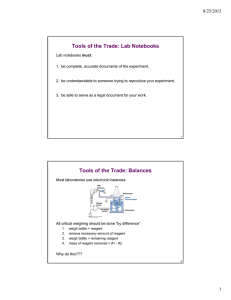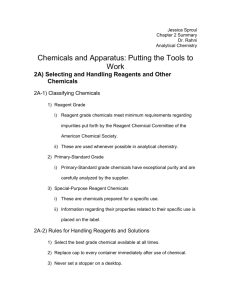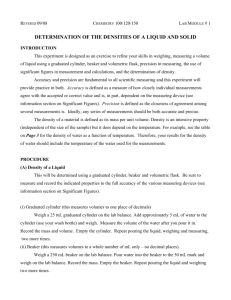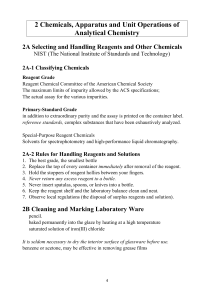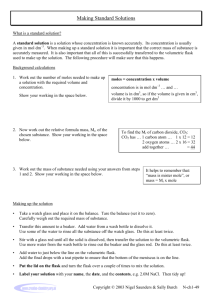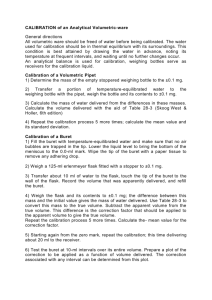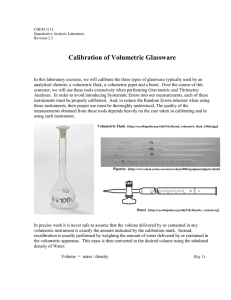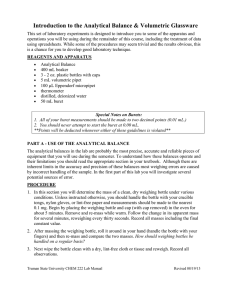Chemicals and Apparatus
advertisement
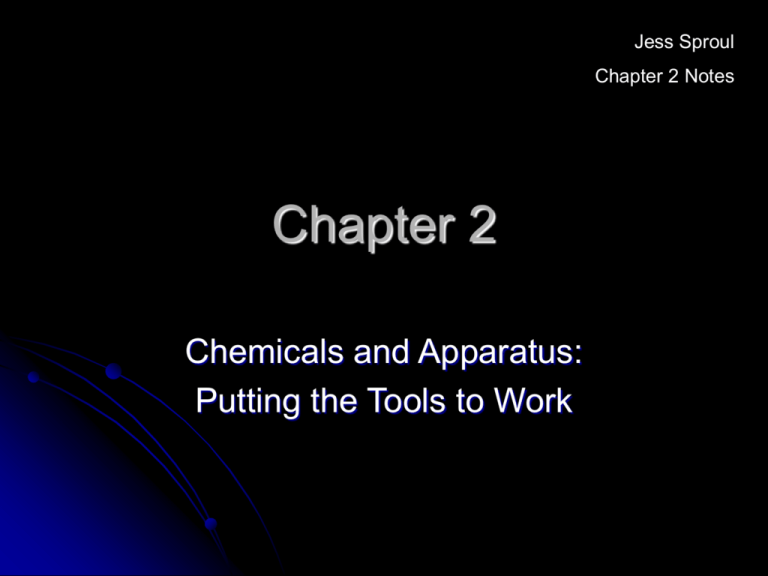
Jess Sproul Chapter 2 Notes Chapter 2 Chemicals and Apparatus: Putting the Tools to Work 2A:Selecting and Handling Reagents and Other Chemicals Select the best grade chemical available at all times. Replace cap to every container immediately after use of chemical. Never set a stopper on a desktop. Never return excess reagent to a bottle. Never insert a spatula, spoon, knife, or other instrument into a solid reagent container. Keep the reagent shelf and lab balance neat and clean. Observe local regulations regarding disposal or surplus chemicals. 2B: Cleaning and Marking Laboratory Ware Mark separate trials individually with pencil, wax pencil, or other marking ink. Clean glassware thoroughly with hot detergent solution, rinsed with tap water, and then rinsed with deionized water. Don’t clean interior of glassware with paper towel as it is a waste of time and could potential contamination. 2C: Evaporating Liquids Evaporation is a good way to decrease the volume of a volatile solution. It is also a good way to eliminate unwanted species, such chloride and the nitrate ion. 2D: Measuring Mass There are different types of balances: Semimicroanalytical Balance: maximum load of 10-30 grams; precision of ±0.01 mg Microanalytical Balance: capacity of 1-3 grams; precision of ±0.001 mg. Follow these instructions when using a balance: Center the load. Protect balance from corrosion. Observe special precautions for weighing liquids. Consult instructor if balance needs adjustment. Keep balance and its case extremely clean. Always allow a heated object to return to room temperature before weighing. Use tongs or gloves to prevent the contamination of a dried sample by the uptake of moisture. 2D-5 Sources of Error in Weighing Errors in weighing should fall well within the limits of the experimental error due to the analytical operations. If, for example, an error of 0.001 g. were made in weighing out a gram sample of fireclay containing 0.25% Of MgO, the resulting error in the determination of the magnesia could be no greater than 0.1% of its value, which is negligibly small. A 1 mg. error, however, made in weighing the 0.0069 g. Of Mg2P207 would involve an error of over 14% in the magnesia value, and this would be intolerable. (http://humboldt.edu/~scimus/Instruments/AnalWgtSmith/AnalWgt.htm) 2E:The Equipment and Manipulations Associated with Weighing Mass can change with the absorption of moisture from the atmosphere. Samples are brought to constant mass by a cycle that involves heating at an appropriate temp., cooled, and then weighed. Constant mass provides some assurance that physical or chemical process that occurred during heating are complete. 2F: The Equipment and Manipulations for Filtration and Ignition Crucibles are used as either containers or filtering devices that allow the supernatant to pass through while retaining the precipitate. Sometimes, filter paper is used and it must be burned off. If this is the case, be sure to handle the heated crucible with care. 2G: Measuring Volume Volume is measured with pipets, burets, and volumetric flasks. Pipets are used for moving specific volumes of liquid from minute amounts to volumes of 25 mL and possibly more. Burets are used for adding small amounts of liquid to a given container at controllable intervals. Volumetric flasks are used for measuring and creating standard solutions. 2H: Calibrating Volumetric Ware Calibrating a Volumetric Pipet Weigh the dry, empty pipet to nearest milligram, then add liquid and weigh again. Use density to determine the actual volume of the liquid. Calibrating a Buret Weigh an empty 125-mL flask, then fill a buret to the 0.00 mL mark. Empty the buret into the flask and use density to determine the true volume. Calibrating a Volumetric Flask Weigh the clean, dry flask to the nearest milligram. Fill to mark with water and reweigh. Calculate true volume using density. 2I: The Laboratory Notebook Record all data and observations directly in lab notebook. Supply each entry with a heading or label. Date each page. Never erase or remove any entry. Never remove a page from notebook. 2K: Safety in the Laboratory Learn location of eye fountain, fire blanket, shower, and fire extinguisher. Wear eye protection at all times. Don’t touch chemicals bare-handed. Never perform unauthorized experiment. Never work alone. Never eat or drink in lab. Always use a bulb to draw liquid into pipet. Wear adequate foot covering. Be careful with heated objects. Always fire-polish ends of freshly cut glass. Never force glass tubing through hole of a stopper. Use fume hoods when evolving harmful gases. Notify instructor of injuries. Dispose of solutions and chemicals as instructed.


